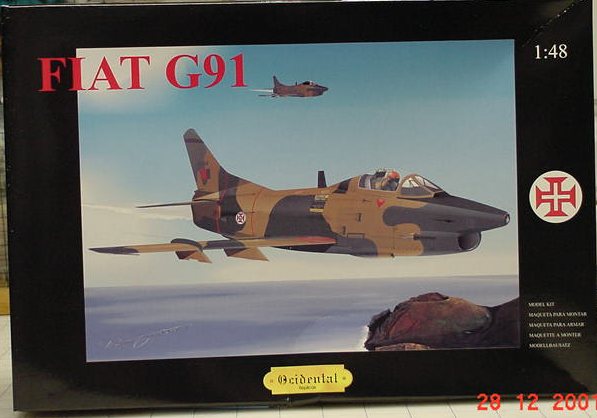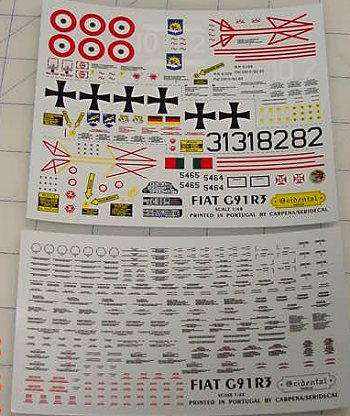
|
KIT: |
Ocidental 1/48 Fiat G.91R |
|
KIT # |
0203 |
|
PRICE: |
FF 139 |
|
DECALS: |
Three aircraft |
|
REVIEW & |
Tracy Palmer |
|
NOTES: |
|

|
HISTORY |
In 1953, NATO announced specifications for a light strike fighter capable of operating from rough airfields, reaching a speed of .92 mach, delivering either conventional or tactical nuclear weapons, and being simple to maintain. Fiat offered up the G-91, which was a scaled down version of the USAF F-86. While the first test flight ended with the pilot ejecting from the plane just before it crashed, the teething problems were fixed. Orders were placed with both the German and Italian Air Forces. In 1966, the Portuguese Air Force (FAP) received their first batch of G-91’s and were soon using the G-91 in combat in Africa. These aircraft served in Guinea, Mozambique, and in Angola throughout the 60’s and 70’s.
When all was said and done, lots of the G-91’s were delivered. Italy received 174, Germany 144 and made another 294 planes under license. The FAP received 59 planes in total. Like all great planes, their time came and all three nations eventually replaced their G-91’s with other aircraft. A German G-91 is in the technical museum at Sinsheim (About 1 ½ hour drive from Frankfurt. A great place to visit if you ever get the chance to get to Germany!)
|
THE KIT |

 The plane comes on a
standard European style box with flaps on the side for access to the parts. The
box art is OK, with the same artwork on the sides as the top. The picture looks
like it may have been computer generated…a shame with so many pictured of the
G-91 in circulation. The basics of the kit are 64 pieces (3 clear ones), an
instructions sheet, and 2 decal sheets (1 national markings, 1 stencils). The
kit is molded in light gray on 2 main runners and has a little flash. There are
recessed panel lines throughout the kit. The instructions are clear and in
three languages. The paint chart does list color references for four major
paint companies plus the FS number.
The plane comes on a
standard European style box with flaps on the side for access to the parts. The
box art is OK, with the same artwork on the sides as the top. The picture looks
like it may have been computer generated…a shame with so many pictured of the
G-91 in circulation. The basics of the kit are 64 pieces (3 clear ones), an
instructions sheet, and 2 decal sheets (1 national markings, 1 stencils). The
kit is molded in light gray on 2 main runners and has a little flash. There are
recessed panel lines throughout the kit. The instructions are clear and in
three languages. The paint chart does list color references for four major
paint companies plus the FS number.
The parts were packed in one large plastic bag, but the not bagged separately. The Clear parts were also in this bag and really need to be bagged separately (I guess I am getting spoiled in my old age!). There are parts for both the R-3 and R-4 versions. The R-3 had two 30mm cannons carried internally, and the R-4 has four .50cal machine guns. The wheel well looks good, but I fear an after market resin kit will be necessary for the cockpit. It’s Spartan to say the least. I believe there are companies at this moment who are already making photo-etched and resin cockpits for this kit. With two choices for versions and three air forces for pick from with decals, I thing it will make a good kit to the ‘Cold War’ ear fighters in your collection. Happy modeling!!
|
REFERENCES |
Lots of internet sites are available on this air craft. A work of caution, a lot were in Portuguese/Spanish. If you like books, I recommend “The Encyclopedia of the Worlds Aircraft”, Salamander books, 1977.
If you would like your product reviewed fairly and quickly by a site that has thousands of visits a day, please contact me or see other details in the Note to Contributors.